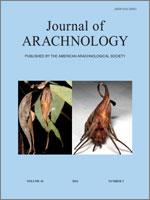Two species of common, farmland-inhabiting money/dwarf spider, Erigone atra Blackwall, 1833 and Oedothorax fuscus (Blackwall, 1834), were exposed to light wind conditions within a wind chamber to determine their propensity to exhibit dispersal behaviors over a nine-month period. A novel design of wind chamber, incorporating two tangential fans, produced a wide outflow thereby allowing behaviors to be expressed over a relatively large test area (1 m × 0.65 m). Sticks placed at 3 cm intervals in an undulating foam surface structurally mimicked a natural field setting. Whereas the majority of E. atra expressed dispersal and related behaviors (tiptoe and drop posture and ballooning) in every month testing occurred, corresponding behaviors were rarely recorded in O. fuscus. Results are discussed in relation to knowledge of the dispersal activity of O. fuscus in the field and factors which may influence dispersal frequency and initiation.
How to translate text using browser tools
1 November 2016
Dispersal behavior in agrobiont spiders (Linyphiidae) — differential response to a wind chamber
Christopher Woolley
ACCESS THE FULL ARTICLE

The Journal of Arachnology
Vol. 44 • No. 3
November 2016
Vol. 44 • No. 3
November 2016
Ballooning
Erigone
Oedothorax




